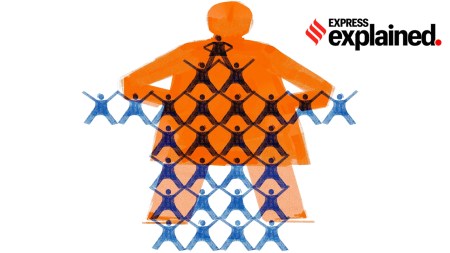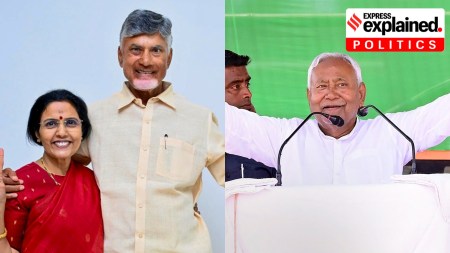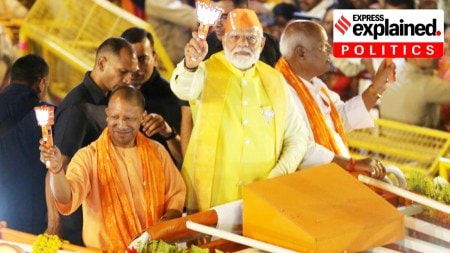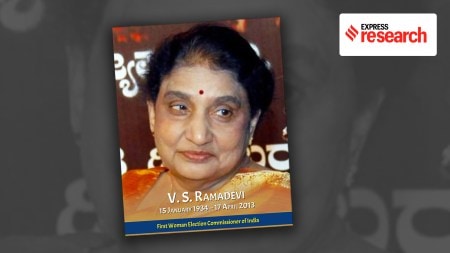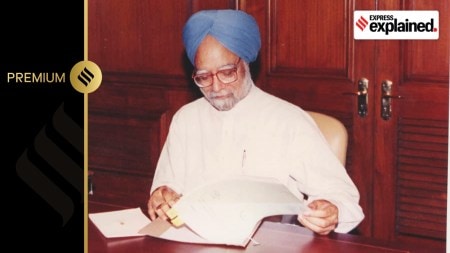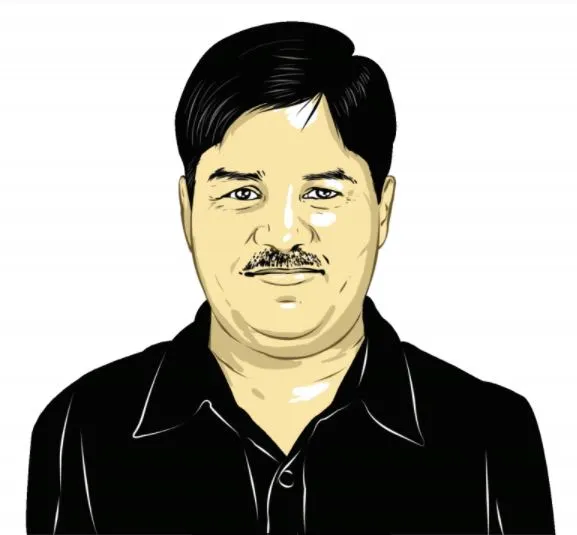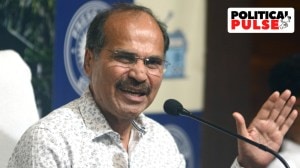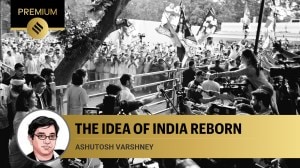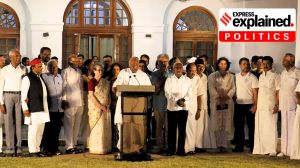- India
- International
How 1989 elections led to a one-year VP Singh term and the arrival of Mandir-Mandal in Indian politics
In the lead-up to the 1989 Lok Sabha elections, Rajiv Gandhi’s aura dissipated rapidly as he made political mistakes and the government was mired in the Bofors corruption scandal. What followed was a turbulent phase in Indian politics. Here is part 9 of our series on the history of Indian elections.
 Prime Minister V P Singh after being sworn in on December 2, 1989, flanked by President R Venkataraman and Rajiv Gandhi to his right, and Vice President Dr Shankar Dayal Sharma and Deputy Prime Minister Chaudhary Devi Lal to his left. (Express Archive)
Prime Minister V P Singh after being sworn in on December 2, 1989, flanked by President R Venkataraman and Rajiv Gandhi to his right, and Vice President Dr Shankar Dayal Sharma and Deputy Prime Minister Chaudhary Devi Lal to his left. (Express Archive)In the Lok Sabha election of 1989, the corruption scandals of Rajiv Gandhi’s tenure overshadowed some significant reforms his government had carried out. For the second time in a dozen years, the Congress lost power at the Centre. But after V P Singh formed a coalition government, Rajiv repeated his party’s “Charan Singh experiment” of 1979 — propping up Chandra Shekhar and, within months, pulling the plug on him. In the space of 19 months in 1989-1991, India saw two Lok Sabha elections and two Prime Ministers.
Reforms and scandal
In December 1988, Rajiv’s government amended Article 326 of the Constitution to lower the voting age to 18 from 21, adding almost 4.7 crore new electors. This was the government’s fourth electoral reform, after the anti-defection law (1985), an amendment to the Companies Act to put additional restrictions on political donations by firms (1985), and a law to prevent misuse of religious institutions and their funds for political interests (1988). Rajiv, who was only 40 when he became Prime Minister, also gave important roles in both the party and the government to younger individuals.
Rajiv’s problems with V P Singh, his Finance Minister, had a lot to do with the several anti-corruption raids that Singh ordered on leading businesspersons, many of whom were the Prime Minister’s friends. As some of these individuals were hauled off to jail and the hue and cry over “raid raj” became louder, Rajiv moved Singh to the Defence Ministry in January 1987.
 Singh congratulates his successor Chandra Shekhar after the latter’s swearing-in on November 10, 1990. (Express Archive)
Singh congratulates his successor Chandra Shekhar after the latter’s swearing-in on November 10, 1990. (Express Archive)
In his new job, Singh announced an inquiry into the Bofors howitzer purchase deal made when Rajiv himself held the portfolio. As relationships in the Cabinet turned increasingly bitter, Singh resigned on April 12, 1987, and left the Congress.
V P Singh vs Rajiv Gandhi
On October 2, 1987, Singh formed a political platform called Jan Morcha. Among those who joined him were Arun Nehru, Rajiv’s cousin who was his close adviser once, and Arif Mohammad Khan, who had quit Rajiv’s government in 1986 over the Shah Bano issue.

In June 1988, V P Singh contested the Lok Sabha bypoll from Allahabad — the incumbent, Amitabh Bachchan, had resigned — as an Independent supported by the Opposition, and won. He began efforts to bring together parties that were part of Janata in 1977 and, on October 11, 1988, the birth anniversary of Jayaprakash Narayan, formed the Janata Dal by merging Jan Morcha with various factions of the Lok Dal and Janata Party.
The Opposition gave the rousing slogan, “Raja [of Manda, Singh] nahin fakir hai, desh ki taqdeer hai (Singh is not a king but an ascetic, the destiny of the nation).”
As V P Singh built his anti-corruption campaign against Rajiv Gandhi, the BJP under L K Advani was aggressively pushing its Hindutva agenda in coordination with the VHP and RSS. The campaign for the construction of a temple in Ayodhya got a fillip after the locks of the Babri Masjid were opened on February 1, 1986, after an order by the Faizabad district court.
The election of 1989
A total 49.89 crore Indians, including new electors between ages 18 and 20, were eligible to vote in 1989. Almost 62% voted in three phases from November 22-26, 1989, for 529 seats (except in insurgency-hit Assam).
Janata Dal won 143 seats — 54 of them in Uttar Pradesh and 32 in Bihar — and the BJP, which had won only two in 1984, shot to 85 seats in the new Lok Sabha. The CPI(M) won 33 seats and the CPI 12. Kanshi Ram’s Bahujan Samaj Party (BSP) won three seats, and Mayawati, just 33 years old then, entered Parliament for the first time.
The Congress, which had won 414 seats in the previous election, suffered a stunning blow but was still the single largest party with 197 seats. It won 39 seats in Andhra Pradesh, 28 in Maharashtra, 27 each in Karnataka and Tamil Nadu, and 14 in Kerala.
After Rajiv declined the invitation to form the government, a National Front coalition led by the Janata Dal took power. Singh was sworn in as Prime Minister on December 2, 1989, with former Haryana Chief Minister Devi Lal as his Deputy.
The BJP and Left Front led by the CPI(M) supported V P Singh’s government from the outside. The CPI(M)’s Harkishan Singh Surjeet and Jyoti Basu, CPI’s Indrajit Gupta, and BJP’s Advani and Atal Bihari Vajpayee met the Prime Minister for dinner and discussions every Tuesday.
Mandal and Mandir
The National Front had the same issues of coordination, conflicting ambitions, and internal weaknesses that had laid the Janata Party low a decade earlier. Devi Lal called V P Singh “spineless” in an interview, which led to his sacking on August 1, 1990. But the firebrand Jat leader, who enjoyed the support of the farming communities, was no pushover.
On August 15, 1990, Singh announced the implementation of the report of the Mandal Commission, which recommended 27% reservation for backward classes in government jobs. One of Singh’s aims was to alienate the OBCs from Devi Lal, whose community, Jat, was not OBC. The announcement led to widespread protests by students and groups including Jats.
On October 23, 1990, Lalu Prasad Yadav’s Janata Dal government stopped Advani’s Somnath-to-Ayodhya Rath Yatra in Bihar’s Samastipur, and arrested the BJP leader. The BJP responded by withdrawing support to the central government. Singh lost a confidence vote on November 7, 1990, and was forced to resign.
Shekhar, the new Charan
In order to form the next government, 64 Janata Dal MPs formed a new faction, the Janata Dal (Socialist), led by Chandra Shekhar, who was sworn in as Prime Minister on November 10, 1990, with Devi Lal as his Deputy.
Like Charan Singh in July 1979, Chandra Shekhar was supported by the Congress from the outside. But this situation was inherently unstable — and once the Congress began levelling allegations that the PM was spying on Rajiv, Chandra Shekhar sensed that the withdrawal of support was near.
On March 6, 1991, the PM resigned and recommended dissolution of Lok Sabha.
Click to read the previous parts of this series: Part 1, part 2, part 3, part 4, part 5, part 6, part 7, and part 8.
More Explained
EXPRESS OPINION
Jun 06: Latest News
- 01
- 02
- 03
- 04
- 05





